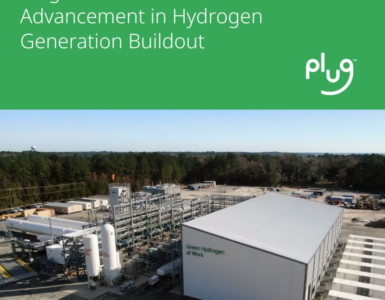Ukraine accelerates towards sustainable hydrogen future despite Russia – HYCAP.
The prospect of a post-war future for Ukraine has emerged, paving the way for the country to implement plans that incorporate a green hydrogen centerpiece, making use of its abundant energy export infrastructure. The development is promising for promoting a more sustainable economic profile throughout Europe.
While hydrogen is primarily recognised as a fuel input for cells and combustible fuel, its applications extend far beyond that. It serves as the driving force behind modernised economies, supporting various industries, including agriculture, food processing, metallurgy, refinery operations and even medicine.
Hydrogen cannot be found in its pure form on Earth, and therefore must be extracted from other sources. Presently, the primary sources of hydrogen are natural gas and coal, which are of course not ideal.
🔥 What about we co-host a webinar? Let's educate, captivate, and convert the hydrogen economy!
Hydrogen Central is the global go-to online magazine for the hydrogen economy, we can help you host impactful webinars that become a global reference on your topic and are an evergreen source of leads. Click here to request more details
However, the prospect of extracting green hydrogen from renewable sources such as water and biogas is advancing rapidly. In the past, electrolysis and other methods for producing green hydrogen were deemed costly, inefficient, and unsupported by public policy. However 2023 has seen marked reduction in electrolyser costs, coupled with the decreasing cost of renewable energy to power them. As a result, energy planners in Ukraine are determined not to be left behind.
In an op-ed last June, Oleksandr Riepkin, Ukraine’s Special Representative of the Minister of Foreign Affairs on Economic Diplomacy, advocated for clean hydrogen. He highlighted that the Ukrainian cities of Zaporizhzhia, Mykolayiv, Odesa, and Kherson receive the same or more sunshine than Italy, and proposed generating green hydrogen from water by utilising electrolysis systems powered by solar energy.
Oleksandr Riepkin, Ukraine’s Special Representative of the Minister of Foreign Affairs on Economic Diplomacy says:
Thanks to these regions alone, Ukraine would be able to provide enough green hydrogen for both domestic needs and the needs of Europe.
At an economic forum in Italy last September, President Volodymyr Zelensky reiterated the proposal. He reminded European leaders that the infrastructure necessary to export hydrogen from Ukraine to western destinations is already established, facilitating Europe’s transition away from “dirty” fuels sourced from Russia and other regions.
President Volodymyr Zelensky, said:
Our country has a huge natural potential for developing opportunities in green energy and in production of green hydrogen.
“This is a potential of tens, and possibly hundreds of green gigawatts of electric power and millions of tonnes of green hydrogen.” said Zelensky.
According to Reuters in January, a preliminary memorandum of understanding was being considered that would involve the European Union providing financial support to establish a green hydrogen sector in Ukraine.
UkraineInvest, the country’s financial agency, reports that Ukraine is considered a “priority partner” for the European Union’s hydrogen initiatives. Pre-war assessments of Ukraine’s wind and solar potential indicate 320 gigawatts of wind and 70 gigawatts of solar capacity, which is just the beginning.
Additionally, the World Bank estimates that 250 gigawatts of renewable energy could be harnessed from stations floating in the waters of Crimea. UkraineInvest predicts that the total renewable energy capacity of over 700 gigawatts could be realised in a decade.
In April it was reported by Reuters, that Denmark and Ukraine signed a five-year energy development agreement that builds upon their cooperative efforts since 2014. The new agreement aims to restore wind farms damaged by the war and develop new wind energy capacity. In the future, offshore wind energy projects are also being considered.
Yaroslav Demchenkov, Ukrainian Deputy Minister of Energy said:
Ukraine can become a hub for Europe’s sustainable energy, and we are setting such ambitious goals as part of our energy sector recovery programs.
“…especially solar and wind generation, as well as hydrogen technologies and bioenergy”.
Carbon Tracker has warned Ukraine must act quickly to keep up with the competition. In a survey released last fall, the organisation reported that other countries were rapidly distancing themselves from Russia’s fossil fuels, resulting in a surge of investment in green hydrogen.
Carbon Tracker said:
War in Ukraine has spurred over $70 billion of fresh investment in green hydrogen in just a few months as costs drop, and has made fossil fuel-produced Hydrogen uneconomic as gas prices soar.
Carbon Tracker warned that due to the increasing prices of gas-feed, about $100 billion worth of “dirty” hydrogen assets may be stranded by 2030. This indicates that the worldwide hydrogen market is moving away from fossil sources, such as natural gas.
Last week, Nel announced the construction of one of the largest electrolyser manufacturing plants in Wallingford, Michigan. The $400 million plant is expected to be fully automated and serve as a model for the global scale-up of electrolyser production.
Nel cited proximity to General Motors as one of the advantages of the Michigan location and mentioned that GM and Nel are collaborating on electrolyser improvements. The new facility highlights the US Department of Energy’s efforts to promote green hydrogen since the early 2000s.
Nel’s CEO said:
Nearly two decades of research investment through the Department of Energy’s Hydrogen and Fuel Cell Office has led to technological advances that will now be transitioned to gigawatt scale in our Michigan facility.
In 2021, Nel informed Reuters that it foresees attaining cost parity for green hydrogen at $1.5 per kilo by 2025. Reuters compared this cost to that of green hydrogen in 2019, which ranged between $2.5 and $4.5 per kilo.
Assuming everything goes as planned, the Nel factory in Michigan is expected to assist in establishing a robust supply chain to aid the Energy Department’s goal of creating a network of regional hydrogen hubs in the United States.
The primary focus of these hubs will be on green hydrogen, but for now at least they must take fossil sources into account, as required by law.
The possibility of green hydrogen beating fossil sources on cost may be subject to change if and when Russia limits itself to its recognised borders.
One thing is for sure, the green energy market is ready to expand for cost-competitiveness.
READ the latest news shaping the hydrogen market at Hydrogen Central
Ukraine Accelerates Towards Sustainable Hydrogen Future Despite Russia, May 9, 2023








